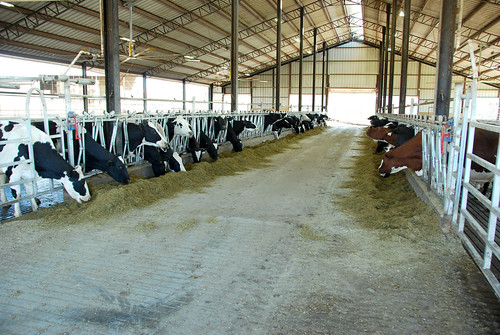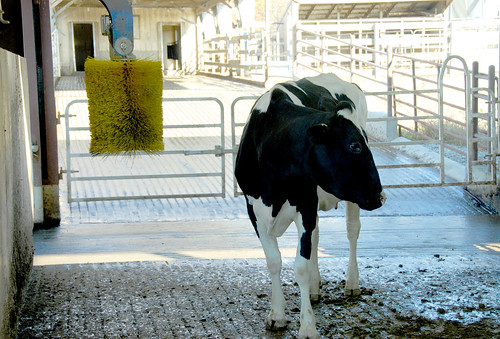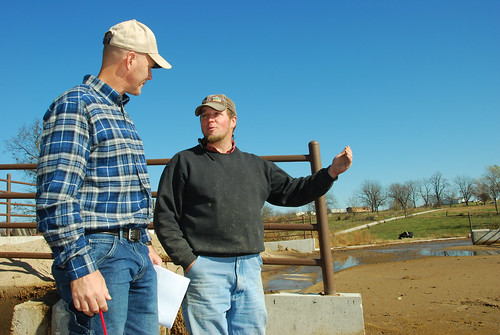
Polk County dairy farmer Nelson Hostetler can think of a ton of reasons to like his new dairy shed and animal waste system. The most obvious reasons are documented in Hostetler’s daily production log. It shows that the 100 cows that formerly resided in a couple of pastures are producing about 2,000 more pounds of milk each day since they were brought in the shed less than a year ago.
“NRCS’ interest is in protecting the quality and healthfulness of the natural resources that everyone needs,” said State Conservationist J.R. Flores. “Situations like Mr. Hostetler’s in which actions taken to protect the environment also improve his operation are great, because everyone benefits.”
“We’re right at 20 pounds more per cow today than we were a year ago,” Hostetler said. “When we built this, we said we had to get six more pounds (for the investment to pay). I expected it to work well, but it’s working better than I expected.”
What Hostetler built, with design and financial assistance from the USDA Natural Resources Conservation Service (NRCS), is a completely covered structure in which the cows rest in stalls bedded with a thick layer of sand. The structure has curtains that can be opened or closed depending on the outside temperature. When the cows want to eat or drink, they leave their stalls and walk across the alleys to get to the food and water.

The alleys are part of a flush system in which water is released from large, gravity-driven flush tanks. The water washes the animals’ waste and sand that gets kicked out of the stalls to an outside area where the sand settles out and the water and waste enters a gravity solid separator. The solid waste remains in the separator and the liquid travels through a pipe to a lagoon. The liquid is then pumped from the lagoon back into the tanks for re-use. The sand is pushed into piles where it dries in the sun, and is put back into the stalls. The solid waste is eventually removed from the separator and spread onto Hostetler’s crop fields.

The shed includes some cow-friendly amenities, such as a spinning brush that cows can activate to brush off dead hair and stimulate new hair growth. While the cows seem content to eat, drink and lie in the stalls when they are not being milked, Hostetler has plans to build some adjacent exercise pens to allow the cows to go outside when the weather is nice.
Hostetler says each cow is producing more milk, and he was able to increase his herd size by 25 percent, up to about 125 cows per day, without increasing his labor.
Hostetler points to one reason for this increased production. “Cow comfort,” he said. “If it rains or snows out there, these cows can just lie in here in the sand and they don’t need to try to find a tree to lie under. The cows can eat, lie down and rest a few hours and then get up and get some more to eat and drink.”
“The condition of the cows is better than it’s ever been with this much milk,” he said. Hostetler has noticed fewer health issues with his cows because the flushed alleys keep them cleaner than when they stood in waste in the feeding area.
Though not as obvious as the milk-production benefits, the system also protects the environment by keeping animal waste on-farm, where it is re-used as nutrients instead of washing into streams.
NRCS engineers worked with Hostetler to design a system to meet his wishes, while also addressing the resource concerns. Michael Malone, NRCS civil engineer, said he, Hostetler, and NRCS Area Engineer John Feistner visited a number of other dairy farms to get ideas about what would work best at Hostetler’s farm.
“We went through multiple design revisions until we finally found one that fit him,” Malone said.
“What I have is kind of what I always dreamed about,” Hostetler said. “Without (NRCS’) help, we would not have been able to do this. We would have had to do it in small stages.”
Through its Environmental Quality Incentives Program (EQIP), NRCS helped cover part of the costs of the shed, flush system, solid waste separator and lagoon.
To learn about the Environmental Quality Incentives Program and how NRCS can help you install conservation practices, contact your local USDA service center or learn how to get started with NRCS online.

